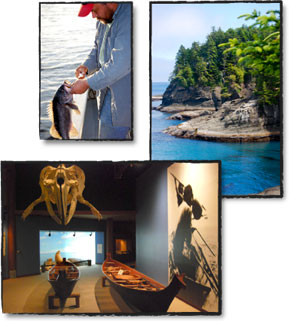



Beaches
Spend the day on Hobuck beach, breathing in some of the world's freshest air. You will find yourself staying until the sun sets. You can find camp sites at Hobuck Beach Campgrounds. Walking along the water’s edge you can lose yourself in the rhythmic crashing of the waves. Hobuck is a popular spot for ocean-kayakers, longboard, or surfing. The breeze blowing in off the ocean is perfect for setting a kite to flying.
Cape Flattery
The trail head is northwest of Neah Bay. Follow the double-yellow line from the Museum right to the trailhead! The trail will lead you through lush forests of old-growth trees 200+ years old. Boardwalks cover marshy areas of the trail. After a short hike the trail ends with platforms for viewing the magnificent rocky cliffs and a wide variety of birds. View caves, sea birds, sea-lions on the off-shore rocks, whales following their migratory route and see where the Pacific Ocean and the entrance of the Straits of Juan de Fuca meet. From this very northwestern tip of the continental United States is a platform for viewing Tatoosh Island. It may feel like you’ve reached the end of the road, but turn around and look – it is just the beginning! Stay a short while and change your perspective.
Fish Hatchery
The Makah National Fish Hatchery is located south of Hobuck and Tsoo-yas beaches and the route is clearly marked with signs. You’ll pass the trail head to Shi-shi Beach and Olympic National Park just before arriving at the Hatchery entrance. Chinook and Coho salmon are raised, along with steelhead. These are released into the tsoo-yas and wa-atch Rivers, which flow through the reservation, into the Pacific Ocean. The fish spend between one and four years at sea before returning. Visitors can watch the fish climb the hatchery's fish ladder into the holding ponds.
Makah National Fish Hatchery
P.O. Box 730 Neah Bay, WA 98357
897 Hatchery Road Neah Bay, WA
www.fws.gov/fish-hatchery/makah/
Hatchery Hours: 7:30 a.m. to 4:30 p.m.
kristin_bates@fws.com
Best time to visit: October thru November, during the primary spawning months.
Marina
The Makah people have a centuries-long association with the sea and fishing. This tradition continues with the Makah Marina, which provides protected moorage for commercial fishing boats, fishing charters and sports fishermen. A tug waits in the harbor to come to the rescue of ships in distress, thus helping avoid disasters.
Museum
The Makah people have lived in the area of Neah Bay for thousands of years. There are four other main, winter villages and numerous summer village sites, but Neah Bay is the center of life in modern times. Makahs graciously share a portion of their heritage at the Museum at the Makah Cultural and Research Center (MCRC).
Visit the Makah Museum, the nation's sole repository for the 500 year old Ozette artifacts. The village of Ozette was located 15 miles south of Neah Bay and served as a year-round home for Makahs until the early 20th-century. A group of longhouses had been covered in a mudslide, perfectly preserving the houses and their contents for several centuries.
Beginning in 1970 and continuing for 11 years, the Makah Tribe and Washington State University excavated 55,000 artifacts that illustrate the Tribe's fascinating history as whalers, sealers, fishermen, hunters, basket weavers, spinners, artists and warriors. The 500 best examples of the Ozette collection are on display, along with dioramas and replica canoes and a full-sized longhouse.
The museum is open year-round, 7days a week from 10AM to 5PM. Guided tours are available for groups, upon request. Exhibits are rotated periodically so visit us often.
Admission: $10 Adults, $8 Students & Senior Citizens
Free for Children under 5
Website: www.makahmuseum.com
